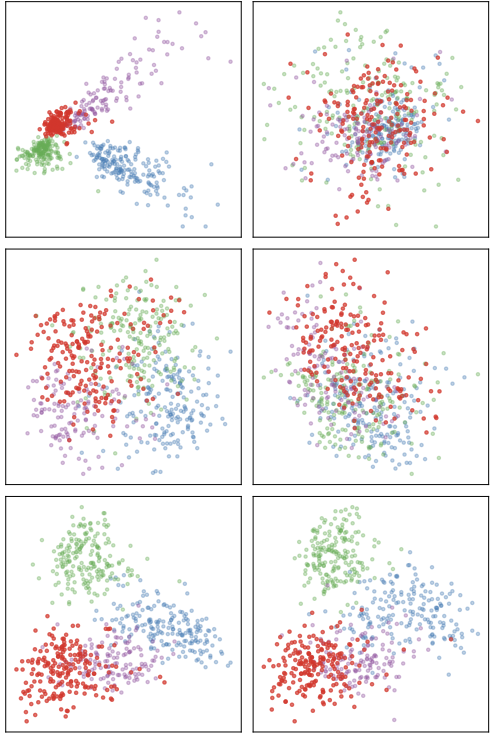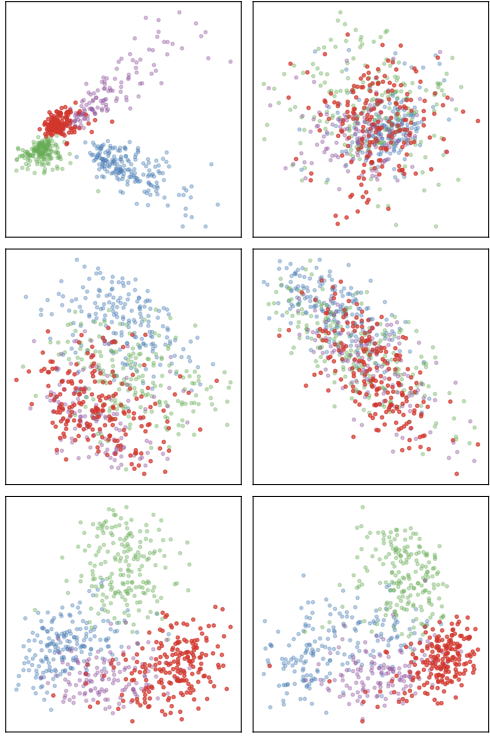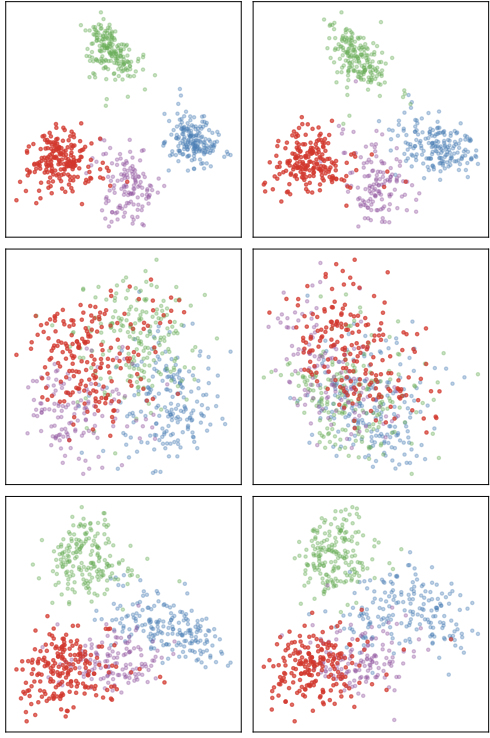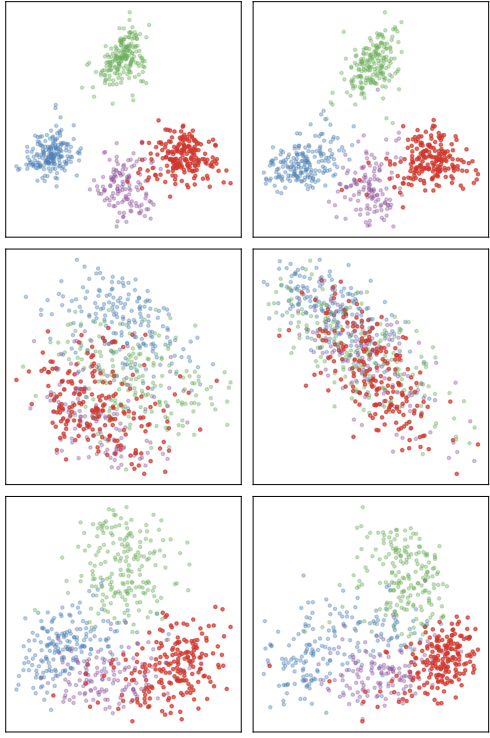Overview
Relative representations enable latent space communication and zero-shot model stitching across different neural networks, but they rely on a critical requirement: parallel anchors—semantically corresponding samples across domains that must be known in advance. In many practical scenarios, obtaining such parallel anchors can be challenging or even impossible.
We present an optimization-based method that discovers new parallel anchors starting from a minimal seed set, reducing the number of required parallel anchors by one order of magnitude. Our approach enables semantic correspondence between different domains, aligns their relative spaces, and achieves competitive results across NLP and Vision tasks.
Background: Relative Representations
Given two domains \(\mathcal{X}\) and \(\mathcal{Y}\) with embedding functions \(E_\mathcal{X}: \mathcal{X} \to \mathbb{R}^n\) and \(E_\mathcal{Y}: \mathcal{Y} \to \mathbb{R}^m\), relative representations transform data samples from absolute coordinates to a relative coordinate system defined by a set of anchors \(\mathcal{A}_\mathcal{X} \subset \mathcal{X}\) and \(\mathcal{A}_\mathcal{Y} \subset \mathcal{Y}\).
For a sample \(x \in \mathcal{X}\), the relative representation is:
\[rr(x, \mathcal{A}_\mathcal{X}) = E_\mathcal{X}(x) \mathbf{A}_\mathcal{X}^T\]where \(\mathbf{A}_\mathcal{X}=\bigoplus_{a \in\mathcal{A}_\mathcal{X}} E_\mathcal{X}(a)\) is the row-wise concatenation of anchor embeddings (all normalized to unit norm).
Parallel anchors \(\mathcal{A}_p \subseteq \mathcal{A}_\mathcal{X} \times \mathcal{A}_\mathcal{Y}\) are pairs of semantically corresponding anchors that enable cross-domain communication. However, obtaining sufficient parallel anchors is often impractical.
Method: Anchor Optimization (AO)
| Our method requires only a small seed set of parallel anchors \(\mathcal{L} = \mathcal{L}_\mathcal{X} \times \mathcal{L}_\mathcal{Y} \subseteq \mathcal{A}_p\), where $$ | \mathcal{L} | \ll | \mathcal{A}_p | $$. We then optimize to discover the remaining anchors. |
Algorithm Overview
The optimization procedure follows these key steps:
- Initialize anchor approximation with seed anchors and random embeddings
- Compute relative representations for both domains
- Estimate correspondence using Sinkhorn algorithm
- Optimize anchor embeddings to minimize alignment error
- Discretize optimized anchors to actual data samples
Initialization
Without prior knowledge of \(\mathcal{A}_\mathcal{Y}\), we initialize:
\[\widetilde{\mathbf{A}}_\mathcal{Y} = \mathbf{A}_{\mathcal{L}_\mathcal{Y}} \oplus \mathbf{N}\]where \(\mathbf{A}_{\mathcal{L}_\mathcal{Y}}\) contains the known seed anchors and \(\mathbf{N} \sim \mathcal{N}(0,\mathbf{I})\) are random embeddings for the unknown anchors.
Optimization Objective
We optimize \(\widetilde{\mathbf{A}}_\mathcal{Y}\) to align the relative spaces:
\[\argmin_{\substack{\widetilde{\mathbf{A}}_\mathcal{Y} \\ \text{s.t. } ||a||_2=1 \; \forall a \in \widetilde{\mathbf{A}}_\mathcal{Y}}} \sum_{y \in \mathcal{Y}} \text{MSE}(rr(\Pi(y), \mathcal{A}_\mathcal{X}), E_\mathcal{Y}(y) \widetilde{\mathbf{A}}_\mathcal{Y}^T)\]where \(\Pi: \mathcal{Y} \to \mathcal{X}\) is a correspondence estimated at each step using the Sinkhorn algorithm, which exploits the current anchor approximation:
\[\Pi = \text{sinkhorn}_{(x,y) \in \mathcal{X} \times \mathcal{Y}}(rr(x, \mathcal{A}_\mathcal{X}), E_\mathcal{Y}(y) \widetilde{\mathbf{A}}_\mathcal{Y}^T)\]Discretization
After convergence, \(\widetilde{\mathbf{A}}_\mathcal{Y}\) is discretized into \(\widetilde{\mathcal{A}}_\mathcal{Y} \subseteq \mathcal{Y}\) by finding the nearest embeddings in \(E_\mathcal{Y}(\mathcal{Y})\).
Experiments
We evaluate our Anchor Optimization (AO) method across multiple tasks, using only 15 seed anchors to discover 300 parallel anchors. We compare against:
- GT (Ground Truth): Using all 300 parallel anchors
- Seed: Using only the 15 seed anchors without optimization
Cross-Domain Word Embeddings
We test on two English word embeddings trained on different data: FastText and Word2Vec, with approximately 20K shared vocabulary words.
Retrieval Performance Visualization


Quantitative Results
| Method | Source | Target | Jaccard ↑ | MRR ↑ | Cosine ↑ |
|---|---|---|---|---|---|
| GT | FT | W2V | 0.34 ± 0.01 | 0.94 ± 0.00 | 0.86 ± 0.00 |
| GT | W2V | FT | 0.39 ± 0.00 | 0.98 ± 0.00 | 0.86 ± 0.00 |
| Seed | FT | W2V | 0.06 ± 0.01 | 0.11 ± 0.01 | 0.85 ± 0.01 |
| Seed | W2V | FT | 0.06 ± 0.01 | 0.15 ± 0.02 | 0.85 ± 0.01 |
| AO (Ours) | FT | W2V | 0.52 ± 0.00 | 0.99 ± 0.00 | 0.94 ± 0.00 |
| AO (Ours) | W2V | FT | 0.50 ± 0.01 | 0.99 ± 0.00 | 0.94 ± 0.00 |
Metrics: Jaccard (discrete similarity), MRR (Mean Reciprocal Rank), Cosine (embedding similarity). All metrics computed with K=10 neighbors, averaged over 20K words across 5 random seeds.
Cross-Lingual Zero-Shot Stitching
We demonstrate cross-lingual model stitching on Amazon reviews in English (en) and Spanish (es), where ground truth parallel anchors are unavailable. Using only 15 out-of-domain (OOD) parallel anchors, our method enables zero-shot stitching: training a classifier on one language and testing on another.
| Decoder | Encoder | GT | Seed | AO (Ours) | |||
|---|---|---|---|---|---|---|---|
| F-score ↑ | MAE ↓ | F-score ↑ | MAE ↓ | F-score ↑ | MAE ↓ | ||
| en | es | 0.51 ± 0.01 | 0.67 ± 0.02 | 0.44 ± 0.01 | 0.80 ± 0.01 | 0.48 ± 0.01 | 0.70 ± 0.02 |
| es | en | 0.50 ± 0.02 | 0.72 ± 0.04 | 0.41 ± 0.01 | 0.92 ± 0.02 | 0.46 ± 0.01 | 0.76 ± 0.02 |
Zero-shot cross-lingual performance on Amazon Reviews fine-grained classification (5 star ratings). Results averaged over 5 random seeds.
Additional Experiments and Visualizations
Baseline Comparison: Detailed Anchor Space Analysis
To better understand the optimization process, we provide detailed visualizations comparing all three methods (GT, Seed, AO) across both optimization scenarios.


Understanding the Visualizations
Each visualization shows three rows representing different methods:
- GT (Top): Ground truth with all 300 parallel anchors known
- Seed (Middle): Using only 15 seed anchors without optimization
- AO (Bottom): Our method discovering 285 additional anchors from 15 seeds
The left and right columns show retrieval from FastText to Word2Vec and vice versa, demonstrating bidirectional semantic correspondence.
Vision Domain: Extending to Visual Encoders
Beyond word embeddings, we demonstrate that our method generalizes to the vision domain using different ViT (Vision Transformer) architectures on CIFAR-10.
Cross-Architecture Vision Retrieval
| Method | Type | Source | Target | Jaccard ↑ | MRR ↑ | Cosine ↑ |
|---|---|---|---|---|---|---|
| GT | Relative | ViT-base | ViT-small | 0.11 ± 0.00 | 0.27 ± 0.01 | 0.97 ± 0.00 |
| ViT-small | ViT-base | 0.10 ± 0.00 | 0.28 ± 0.01 | 0.97 ± 0.00 | ||
| Seed | Relative | ViT-base | ViT-small | 0.03 ± 0.00 | 0.03 ± 0.01 | 0.97 ± 0.00 |
| ViT-small | ViT-base | 0.03 ± 0.00 | 0.04 ± 0.01 | 0.96 ± 0.00 | ||
| AO (Ours) | Relative | ViT-base | ViT-small | 0.10 ± 0.01 | 0.23 ± 0.03 | 0.97 ± 0.00 |
| ViT-small | ViT-base | 0.10 ± 0.00 | 0.28 ± 0.01 | 0.97 ± 0.00 |
Cross-architecture retrieval on CIFAR-10 using ViT-base (768-dim, pre-trained on JFT-300M + ImageNet) and ViT-small (384-dim, pre-trained on ImageNet). Results demonstrate generalization beyond NLP to vision domains.
Key Findings
1. Dramatic Supervision Reduction
Our method achieves competitive performance with one order of magnitude fewer parallel anchors (15 vs. 300), drastically reducing annotation requirements.
2. Outperforms Ground Truth
In retrieval tasks, optimized anchors can exceed the performance of using all ground truth anchors, suggesting the optimization discovers highly informative positions.
3. Cross-Domain Effectiveness
Proven effective for both NLP (word embeddings, cross-lingual transfer) and Vision tasks (visual encoders with different architectures).
4. Practical Applicability
Enables latent space communication in scenarios where obtaining extensive parallel supervision is impractical or impossible.
5. No Retraining Required
The method is optimization-based and does not require retraining the underlying models, making it immediately applicable to pre-trained systems.
Citation
@article{cannistraci2023bootstrapping,
title = {Bootstrapping Parallel Anchors for Relative Representations},
author = {Cannistraci, Irene and Moschella, Luca and Maiorca, Valentino and
Fumero, Marco and Norelli, Antonio and Rodol{\`a}, Emanuele},
journal = {arXiv preprint arXiv:2303.00721},
year = {2023}
}
Authors
Irene Cannistraci · Luca Moschella · Valentino Maiorca · Marco Fumero · Antonio Norelli · Emanuele Rodolà
Sapienza University of Rome, Italy
Implementation Details
- Optimizer: Adam
- Learning Rate: 0.02 (retrieval), 0.05 (stitching)
- Optimization Steps: 250 (retrieval), 125 (stitching)
- Loss Function: MSE (Mean Squared Error)
- Constraint: Unit norm (||a||₂ = 1) via GeoTorch
- Epsilon: 1e-4
- Stop Error: 1e-5
- Iterations: 1 per optimization step
- Purpose: Compute soft correspondence between domains
- PyTorch Lightning: Reproducible training pipeline
- GeoTorch: Unit norm constraints on anchors
- Sinkhorn Algorithm: Fast approximate Wasserstein distances
- HuggingFace Transformers: Pre-trained models
- HuggingFace Datasets: NLP datasets and CIFAR-10
- DVC: Data versioning and experiment tracking
Future Work and Limitations
While this work significantly reduces the number of required parallel anchors, future research directions include:
Eliminating the Seed Requirement
Exploring methods that can discover parallel anchors without any initial supervision through purely unsupervised approaches.
Scaling to Millions of Anchors
Extending the approach to handle very large-scale anchor discovery for applications requiring extensive semantic correspondence.
Multi-Domain Scenarios
Generalizing beyond pairwise domain alignment to multiple domains simultaneously for complex multi-modal systems.